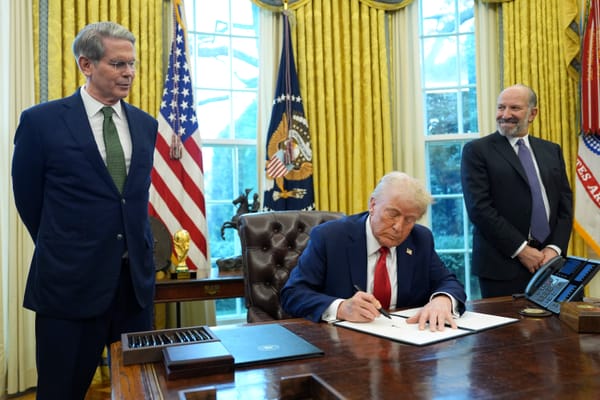Today, we arrive at President Donald Trump’s heralded “Liberation Day,” in which broad tariffs will be implemented in response to manufacturing and trade imbalances. The basic problem with Trump’s agenda is that America’s real enemy is not the rest of the world, but its native oligarchy of financial imperialists. This domestic nemesis is the fusion of the Finance, Insurance, and Real Estate (FIRE) sector and the foreign-policy establishment. The FIRE sector stymies productive sectors and increases inequality, while the foreign-policy establishment wastes American blood and treasure on conflicts of no or negative national interest.
Any American can see that these two groups have gone off the rails. Mortgage-backed securities didn’t make anyone’s lives better, nor did the Iraq War. The popular backlash against these excesses helped enable Trump’s rise to power, and his attempt to rebalance trade responds to a discontent with the prevailing economic order of recent decades. Unsurprisingly, the FIRE and foreign-policy elites hate the tariff agenda. But the promised economic paradigm shift will be a failure without a systematic, disciplined effort to bring these two groups under control.
The foreign-policy establishment seeks to maintain American global hegemony through the combination of the US dollar as the global reserve currency, fiscal deficits, and balance of payments deficits. In 1944, at the Bretton Woods Conference, the dollar became the agreed upon world reserve currency. After 1970, American fiscal deficits became bigger and more constant, except for a brief period of fiscal surpluses from 1998 to 2001. Since then, fiscal deficits have rapidly increased. The fiscal deficit amount in 2024 was about eight times the greatest fiscal surplus amount in 2000. America began running persistent and large balance of payments deficits at the turn of the 1980s.
This combination of factors results in the rest of the world having a surplus of dollars, which circulate back into dollar-denominated investments. These foreign dollar surpluses favor FIRE assets and US treasuries. Thus, global American imperium funds the FIRE sector, and the FIRE sector then funds the structures that further entrench and enable US imperialism.
For this system to have emerged in the first place, the United States had to deindustrialize. An America that maintained strong manufacturing would not have been able to pull off this vicious cycle because it would have had balance of payments surpluses. By allowing foreign countries to grow their manufacturing sectors, America ensures that the more goods it buys from foreign countries, the more dollars those countries send back into the FIRE sector and US treasuries.
If America had maintained manufacturing and balance of payments surpluses, that would have led to domestic political debates on how to spend those surpluses. The popular position would have been to invest them in productive sectors that supplied good wages and real goods. This would have been bolstered by a manufacturing sector supporting a politically strong labor movement. Deindustrialization disintegrated labor as a competitive and unified bloc. The FIRE sector has grown disproportionately relative to the real productive economy, while also siphoning capital away from the productive sectors. The resulting increase in inequality exacerbates the diminishment of checks and balances, as oligarchs came to wield disproportionate influence on academia, media, and political campaigns.
Trump’s crusade to rebalance trade is occurring because the vicious cycle propping up the FIRE sector at the expense of the American people is breaking down. The rise of the multipolar world order disrupts the American oligarchy’s interests. The modernization and economic development of the rest of the world reduces the need for other countries to rely on American imperial hegemony. There are more trade opportunities than ever outside America. Other countries are less reliant on access to American markets, weakening the dollar’s status as reserve currency.
“America can’t do this overnight.”
Any gains for the productive economy from Trump’s tariffs will likely be sabotaged by the FIRE sector’s malinvestment of capital and the foreign-policy establishment’s unwillingness to withdraw from the world. America can’t have its cake (of maintaining the dollar as the global reserve currency) and eat it too (bringing back manufacturing and resolving trade imbalances). The oligarchy cannot be expected to act in America’s best interests, because that is at the expense of its interests.
Ending the rule of the American oligarchy would require reductions of military spending, ending proxy conflicts, closing bases, and embracing diplomacy. For the FIRE sector, this would entail taxing financial transactions, using central bank window guidance, and establishing a national development bank to direct investment into productive sectors and not to asset price inflation. Tariff policy wouldn’t be used as a retaliatory action, but as a targeted and measured policy tool for incubating critical domestic industries.
Such an approach would set America up on the path toward reindustrialization and trade imbalance corrections. Liberating America from oligarchy would replace the vicious cycle with a virtuous one. But America can’t do this overnight. We need years, if not decades.
